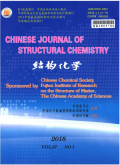π-π Stacking, Hydrogen Bonding and Magnetic Coupling Mechanism on a Mono-nuclear Cu^Ⅱ Complex
基本信息来源于合作网站,原文需代理用户跳转至来源网站获取
摘要:
A new mono-nuclear CuII complex [Cu(DPP)(DP)Br](ClO4)H2O (DPP = 2-(3,5- dimethyl-1H-pyrazol-1-yl)-1,10-phenanthroline, DP = 3,5-dimethyl-1H-pyrazole) has been syn- thesized with 2-(3,5-dimethyl-1H-pyrazol-1-yl)-1,10-phenanthroline and 3,5-dimethyl-1H-pyrazole as ligands, and its crystal structure was determined by X-ray crystallography. The crystal is of monoclinic system, space group P21/c with a = 13.765(2), b = 17.044(3), c = 10.9044(16), β= 97.112(2)°, V = 2538.5(6)3, Z = 4, C22H24BrClCuN6O5, Mr = 631.37, Dc = 1.652 g/cm3, F(000) = 1276 and μ= 2.585 mm-1. In the crystal, DPP functions as a tridentate ligand and CuII ions assume a distorted square pyramidal geometry with Br atom lying on the apex, and at the same time, there is π-π stacking between adjacent complexes, which deals with two 1,10-phenanthroline plane rings. In addition to the π-π stacking, there are C-H···Br non-classic hydrogen bonds between adjacent complexes. The theoretical calculations reveal that the π-π stacking and C-H···Br non-classic hydrogen bond result in a weak anti-ferromagnetic interaction with 2J = -5.34 cm-1 and a weak ferromagnetic 2J = 5.92 cm-1, respectively. The magnetic coupling sign from the π-π stacking could be explained with McConnell I spin-polarization mechanism.

推荐文章
Prospectivity modeling of porphyry copper deposits: recognition of efficient mono- and multi-element
Geochemical signature
Concentration–area (C–A) fractal
Principal component analysis (PCA)
Student's t-value
Fuzzy mineral prospectivity modeling(MPM)
Prediction–area (P–A) plot
Magnetic Influences of Cement Dust on Soil in Industrial Area and Its Environmental Implications
Cement dust
Soil
Magnetic property
Environmental significance
基于Stacking方法的多策略本体映射
本体映射
Stacking方法
概念相似度
分类
Snowball Earth at low solar luminosity prevented by the ocean–atmosphere coupling
Faint Young Sun paradox
Carbon dioxide
Earth system
Siderite
内容分析
关键词云
关键词热度
相关文献总数
(/次)
(/年)
引文网络
引文网络
二级参考文献 (0)
共引文献 (0)
参考文献 (12)
节点文献
引证文献 (0)
同被引文献 (0)
二级引证文献 (0)
1981(1)
- 参考文献(1)
- 二级参考文献(0)
1988(2)
- 参考文献(2)
- 二级参考文献(0)
1992(1)
- 参考文献(1)
- 二级参考文献(0)
1997(1)
- 参考文献(1)
- 二级参考文献(0)
1998(1)
- 参考文献(1)
- 二级参考文献(0)
2000(1)
- 参考文献(1)
- 二级参考文献(0)
2002(1)
- 参考文献(1)
- 二级参考文献(0)
2005(1)
- 参考文献(1)
- 二级参考文献(0)
2006(1)
- 参考文献(1)
- 二级参考文献(0)
2008(2)
- 参考文献(2)
- 二级参考文献(0)
2012(0)
- 参考文献(0)
- 二级参考文献(0)
- 引证文献(0)
- 二级引证文献(0)
研究主题发展历程
节点文献
耦合机制
堆叠
氢键
单核
反铁磁相互作用
晶体结构测定
邻菲罗啉
三齿配体
研究起点
研究来源
研究分支
研究去脉
引文网络交叉学科
相关学者/机构
期刊影响力
结构化学
主办单位:
中国化学会
中国科学院福建物质结构研究所
出版周期:
月刊
ISSN:
0254-5861
CN:
35-1112/TQ
开本:
出版地:
福建省福州市杨桥西路155号
邮发代号:
创刊时间:
语种:
eng
出版文献量(篇)
5114
总下载数(次)
0
总被引数(次)
8477
期刊文献
相关文献
推荐文献
- 期刊分类
- 期刊(年)
- 期刊(期)
- 期刊推荐
力学
化学
地球物理学
地质学
基础科学综合
大学学报
天文学
天文学、地球科学
数学
气象学
海洋学
物理学
生物学
生物科学
自然地理学和测绘学
自然科学总论
自然科学理论与方法
资源科学
非线性科学与系统科学
结构化学2022
结构化学2021
结构化学2020
结构化学2019
结构化学2018
结构化学2017
结构化学2016
结构化学2015
结构化学2014
结构化学2013
结构化学2012
结构化学2011
结构化学2010
结构化学2009
结构化学2008
结构化学2007
结构化学2006
结构化学2005
结构化学2004
结构化学2003
结构化学2002
结构化学2001
结构化学2000
结构化学1999
结构化学2012年第9期
结构化学2012年第8期
结构化学2012年第7期
结构化学2012年第6期
结构化学2012年第5期
结构化学2012年第4期
结构化学2012年第3期
结构化学2012年第2期
结构化学2012年第12期
结构化学2012年第11期
结构化学2012年第10期
结构化学2012年第1期

 免费查重
免费查重










